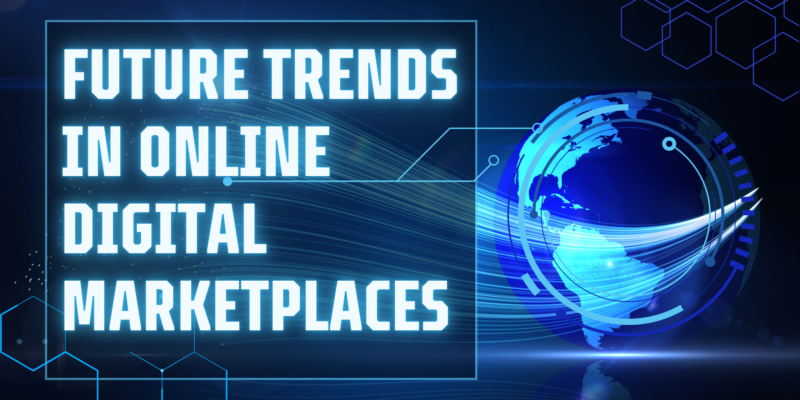Marketplaces on the internet are drawing an array of users. They range from brands that reinvent their role as marketplaces to companies purchasing and investing into them; the future of these platforms looks bright. To ensure the success of their businesses, online marketplace managers must be aware of the latest trends in their industry. The most intriguing trends include virtual reality, 3D visuals, and live buying.
New and Upcoming Marketplaces to Watch
An array of market trends are influencing the future of e-commerce. The market trends that are shaping the future of commerce are affected by various elements, such as customer preference as well as technological advances.
In particular, online marketplaces can optimize their search for voice-based commerce by using natural language processing technologies for a better and user-friendly experience. It helps them build a loyal audience with people who are tech-savvy and also improves the conversion rate and increases the revenue stream.
A different trend emerging in the market is the subscription-based model. The subscription model provides a more convenient and quick shopping experience as well as allows merchants to increase loyal customers and boost revenue. Examples include beauty items and pet items that are often offered through subscriptions, and the businesses that offer these services have experienced a steady growth in their popularity.
Additionally, social media platforms have a significant impact on the future of internet marketplaces. The world of social media is one of the fastest-growing sales channels in the field of e-commerce. Online marketplaces allow customers to purchase through their preferred social media websites and reduce the amount of time needed to consult and order products.
As well as boosting engagement, social media marketplaces are adopting omnichannel experiences with choices that include ROPO (research online, purchase offline) as well as BOPIS (buy online, pick up in-store). The e-commerce industry is also highlighting the necessity for retailers to use a common customer information platform that provides a complete and real-time overview of customer behaviors across various channels.
Voice Commerce
Utilizing voice technology is essential for online stores that want to stay current and relevant. The technology provides shoppers with convenience and a hands-free shopping experience that speeds up the process of checkout and allows customers to multitask. Additionally, it permits retailers to improve their product listings and content to accommodate voice searches, thereby increasing exposure and reaching a larger market.
Moreover, the use of voice commerce is an effective technology that will enhance customer satisfaction and retention while increasing the profitability of marketplaces, as it facilitates a speedier purchase process that is more user-friendly. Additionally, it allows sellers to give personalized advice and expedite the checkout process to improve customer satisfaction.
A new trend in online shopping to keep an eye on is the social commerce market, which allows users to purchase products directly on popular social media platforms, including Instagram and TikTok. This is a highly efficient sales channel, helping sellers extend their reach and connect with a younger demographic.
Furthermore, the use of social commerce enables consumers to complete their purchases with flexible payment options. These include modern digital wallets, such as Google Pay and Apple Pay, as well as more recent alternatives like cryptocurrencies and Buy Now, Pay Later (BNPL) plans. A wide selection of payment options is crucial for online marketplaces to align with changing consumer needs and keep up with future demands.
Social Commerce
Shopping on social media is one of the most popular trending areas of e-commerce, with platforms such as TikTok and Instagram allowing users to purchase items directly through their applications. This makes purchasing more efficient and less time-consuming for customers.
More shoppers are searching for discounts and a customized shopping experience tailored to their individual needs. To meet this demand, numerous marketplaces have embraced personalized capabilities to learn more about customer preferences and shopping habits. In particular, certain marketplaces are using AI-powered recommendation engines that provide targeted offers and recommendations based on individual user data.
In addition, some online markets are using social media platforms to allow users to save and then simply share the products they like. For instance, On Instagram customers can also add a “buy” button to their product pins to make it easier for other users to purchase through their feed mobile skin templates. Furthermore, some marketplaces, including Pinterest let users save their Product Pins to their shopping lists and also receive price updates. This allows for quick and easy online shopping.
Another trend happening in the market is the surge of uber-apps, which offer a range of products and services from various vendors via a single user interface. The Singapore-based Grab is an excellent illustration of this, offering transport, meal, and shopping delivery services, along with financial services, all through a one-stop digital wallet.
Artificial Intelligence
One of the major developments in the world of online marketplaces is the rapid growth of AI. AI helps make online marketplaces more personal, efficient, and productive by automating processes that would otherwise require human intervention. Additionally, it improves customer experience and increases sales. As AI tools become more advanced and integrated into daily life, there are increasing concerns regarding the data they collect and how it is used. A majority of consumers are demanding that companies establish stronger ethical and compliance guidelines governing the use of AI tools.
Consequently, there is a rising demand for more explainable AI, allowing the algorithms powering AI systems to be more transparent. This could enhance confidence and trust in these products, while also reducing the potential for data misuse and minimizing bias, which can be a significant issue in certain sectors.
Social media sites like Instagram, TikTok, and Facebook have been incorporating more shopping features into their applications, simplifying the process for consumers to search and purchase products via their feeds. This trend is expected to continue over time. Other innovations include ROPO (research online, buy offline) and BOPIS (buy online, pick up in-store). These developments highlight the importance of a seamless, omnichannel experience.













